Victoria is home to some incredible and diverse snake species. They range from constrictors to highly venomous snakes. Unfortunately, many of these snakes make their way into people’s homes, so when living in this state, it is essential to identify which are venomous. But these snakes don’t just invade people’s homes. They are also found in many waterways in the state. While the only real watersnakes are sea snakes, there are several semi-aquatic species in Australia. However, all snake species can swim. So, if you want to find some relief from the sweltering summers, be cautious when visiting these snake-infested lakes in Victoria.
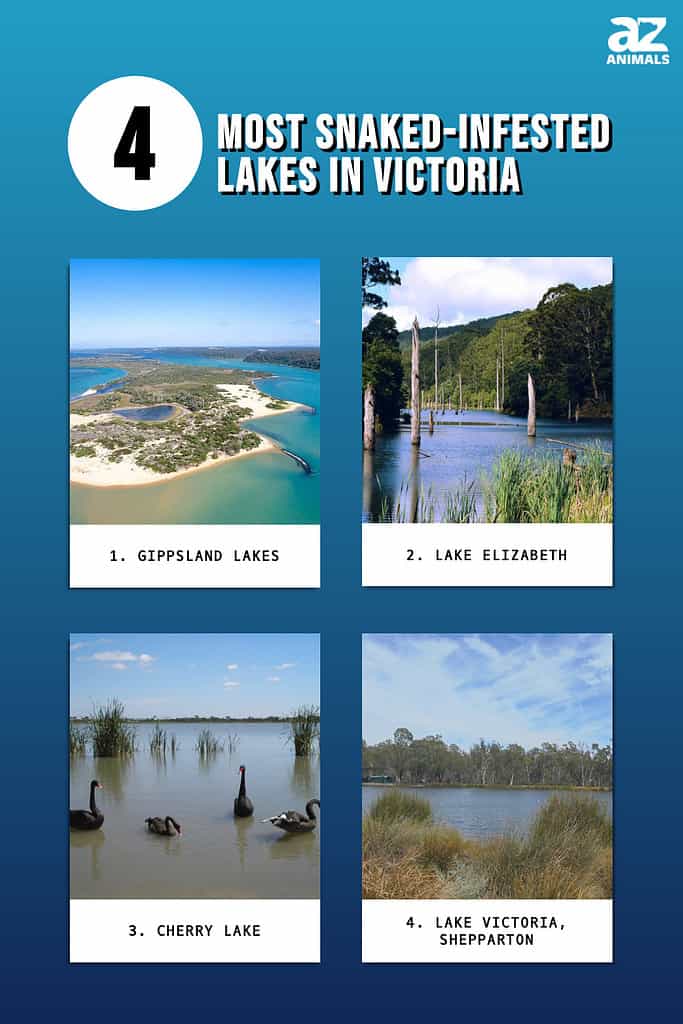
Snake Species Found in Victoria
Victoria is home to 27 different species of snakes. Most of these are venomous and have a higher probability of being dangerous. Of these, there are a few that are more often seen than others. Here are the five snake species commonly found in Victoria:
Mainland Tiger Snake
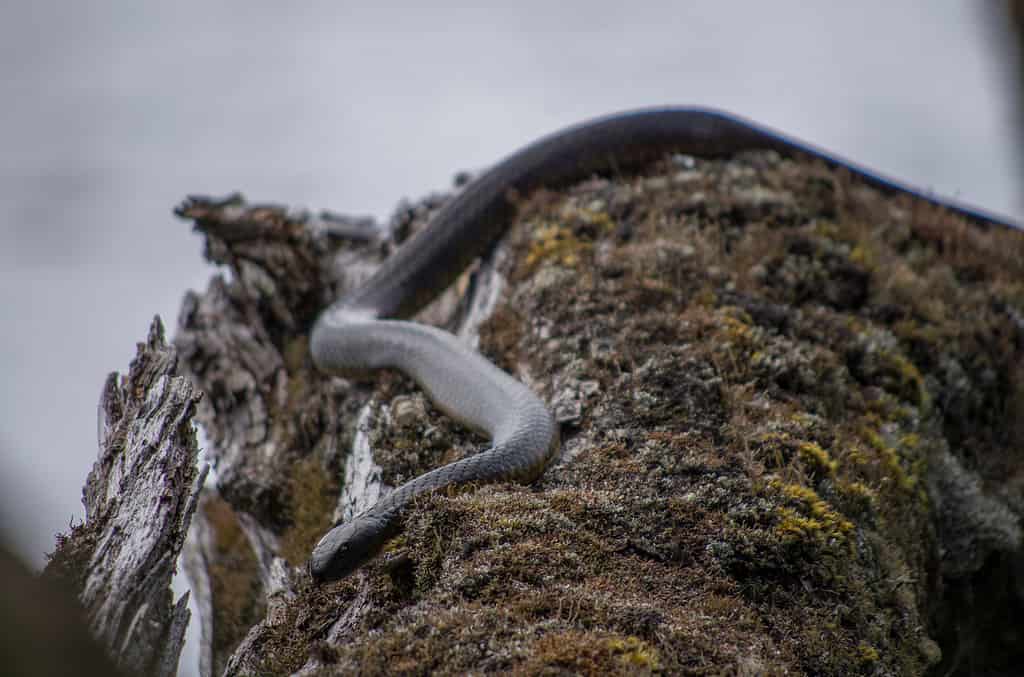
tiger
snakes are often found in large numbers in areas with plenty of food within close proximity to each other. These snakes are highly venomous, and their bites are potentially fatal to humans.
©Benoit MOREL/Shutterstock.com
The mainland tiger snake is a highly variable species, as it does not always exhibit the distinctive tiger stripes as its name suggests. For example, they can have olive-brown, gray, and black bodies. Furthermore, most variations have darker bands, which are visible. The areas between the bands are typically cream or light brown in color. However, some specimens may have bright yellow coloring between the bands.
Their bellies are generally creamy-yellow, but some have bright yellow undersides. These snakes usually occur in southeastern Australia’s wetlands, swamps, and water courses. Additionally, tiger snakes are often found in large numbers in areas with plenty of food within close proximity to each other. These snakes are highly venomous, and their bites are potentially fatal to humans.
Carpet Python
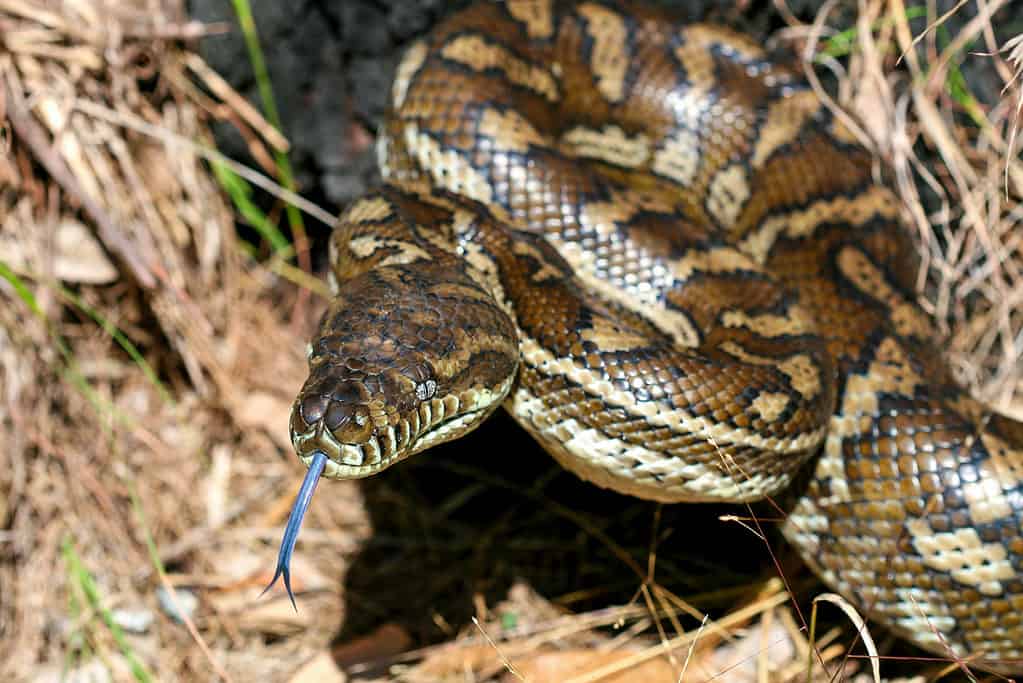
Carpet pythons occur throughout Australia, except in the extreme southeastern and central western regions, as well as New Guinea.
©Michelle Marks/Shutterstock.com
These pythons are medium in size and named after the stunning patterns on their bodies, which look similar to an oriental carpet pattern. For example, they can display gray-to-black patterns of blotches, stripes, cross bands, or a mix of all these markings on a light brown to yellow background. Males can measure between 6.5 to 12 feet long, but the average adult length is approximately 8 feet. Carpet pythons occur throughout Australia, except in the extreme southeastern and central western regions, as well as New Guinea. They inhabit a wide variety of habitats, like central desert areas and eastern coastal rainforests.
Eastern Brown Snake

The eastern brown snake typically has a pale to dark brown body with a gray, cream, or yellow belly with orange blotches. Additionally, they often have darker patterns towards their tails.
©Ken Griffiths/Shutterstock.com
This snake is long and slender. The eastern brown snake typically has a pale to dark brown body with a gray, cream, or yellow belly with orange blotches. Additionally, they often have darker patterns towards their tails. These snakes are highly venomous and extremely harmful to pets and humans. Eastern brown snakes usually inhabit rock crevices, hollow logs, unused animal burrows, and around buildings under trash. Furthermore, they have adapted well to grazed, farmed, and semi-urban environments.
Red-bellied Black Snake

These snakes are venomous, but there have been no human fatalities resulting from their bite in Australia. The red-bellied black snake inhabits areas around water bodies and usually occurs near swamps, lakes, wet forests, and creek banks.
©Ken Griffiths/Shutterstock.com
These snakes can grow up to 8 feet long, but adults generally average around 5 feet long. Red-bellied black snakes derived their name from their bright, shiny black backs, with creamy pink to vibrant red bellies. In addition, they have brown snouts. These snakes are venomous, but there have been no human fatalities resulting from their bite in Australia. The red-bellied black snake inhabits areas around water bodies and usually occurs near swamps, lakes, wet forests, and creek banks.
Lowland Copperhead
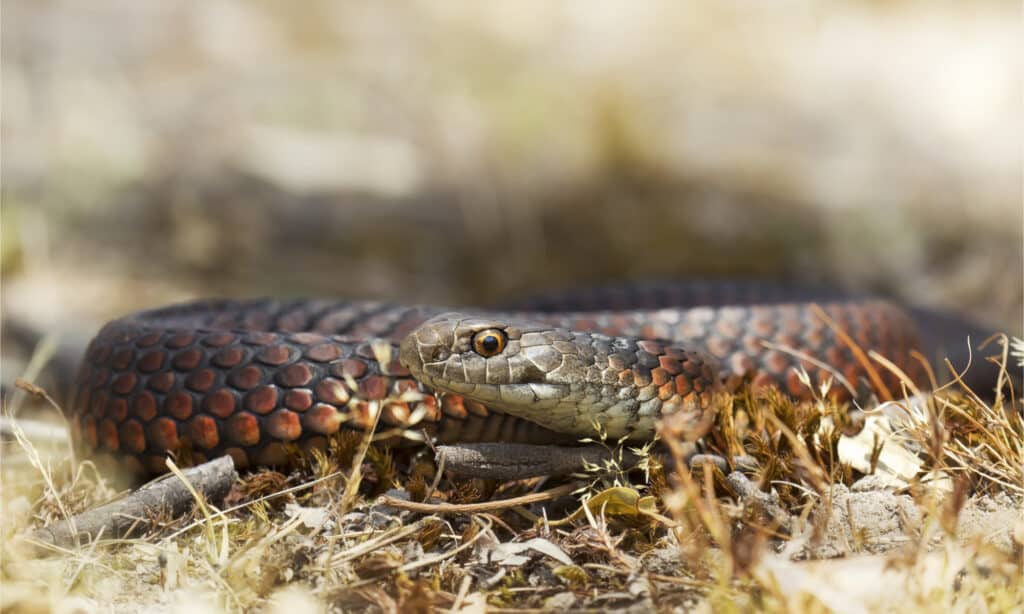
The lowland copperhead is venomous, and there have been 12 reported bites in Australia, resulting in one fatality.
©Austrelaps superbus/Shutterstock.com
Lowland copperheads usually measure around 3 to 5 feet long. They vary in color from yellow, red, gray, black, and coppery mid-brown. While they derived their name from the copper color on their heads, not all variations have that coloring. These snakes occur in southeastern Australia, including Tasmania. They like to inhabit areas with low vegetation near bodies of water, where they prey on lizards, frogs, and other snakes, including juveniles of their own species. Lowland copperheads are venomous, and there have been 12 reported bites in Australia, resulting in one fatality.
The Most Snake-Infested Lakes in Victoria
1. Gippsland Lakes
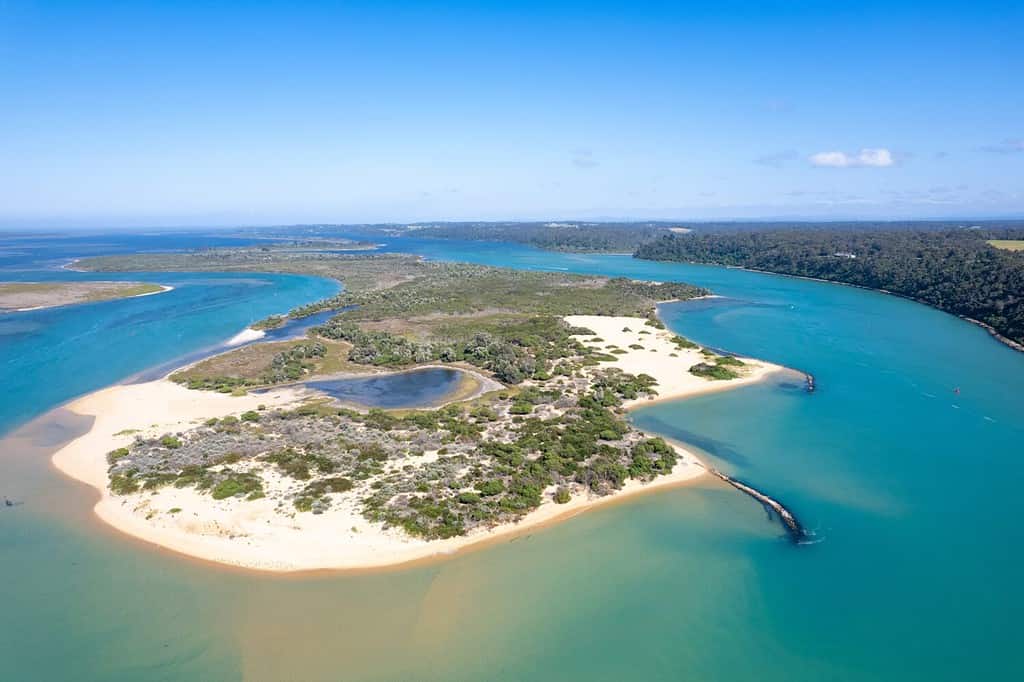
Gippsland Lakes is one of the most snake-infested lakes in Victoria. Snake species that are commonly found in this area include lowland copperheads, tiger snakes, eastern brown snakes, and red-bellied black snakes.
©murbansky/Shutterstock.com
Gippsland Lakes is Australia’s largest inland waterways. It consists of a network of marshes, lakes, and lagoons over 231 square miles. Gippsland Lakes is one of the most snake-infested lakes in Australia. Snake species that are commonly found in this area include:
- Tiger snakes
- Lowland copperheads
- Eastern Brown snakes
- Red-bellied black snakes
2. Lake Elizabeth
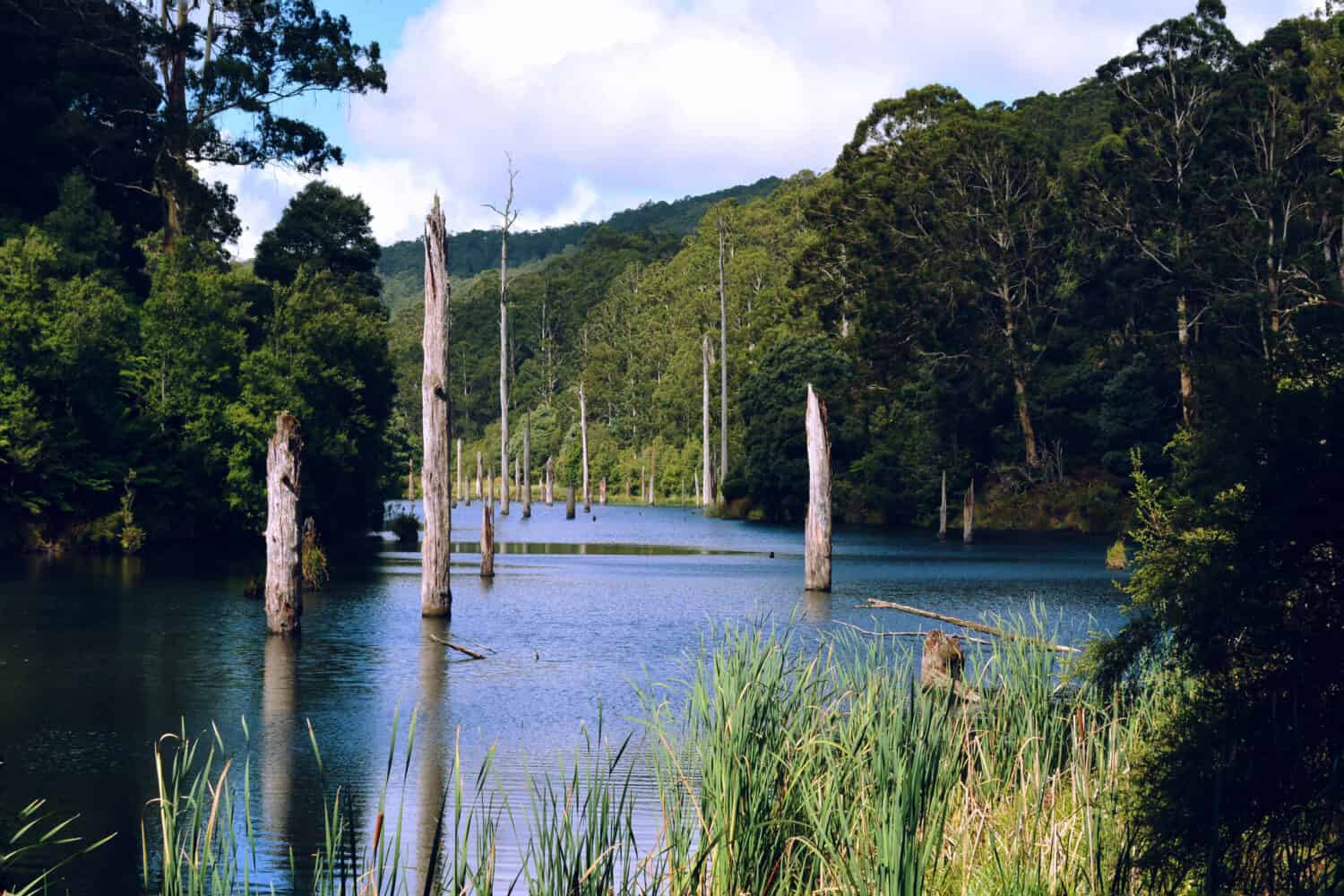
Lake Elizabeth is a two-hour drive from Melbourne, nestled in the Great Otway National Park. Visitors are struck by this lake-inspiring beauty, with calm waters dotted with dead trees that drowned more than half a decade ago.
Image: Danielay, Shutterstock
©Danielay/Shutterstock.com
Lake Elizabeth is a two-hour drive from Melbourne, nestled in the Great Otway National Park. Visitors are struck by this lake-inspiring beauty, with calm waters dotted with dead trees that drowned more than half a decade ago. Furthermore, this lake is home to the elusive platypus. However, it is one of the most snake-infested lakes in Victoria. Snake species that occur around Lake Elizabeth include lowlands copperheads, tiger snakes, and white-lipped snakes.
3. Cherry Lake
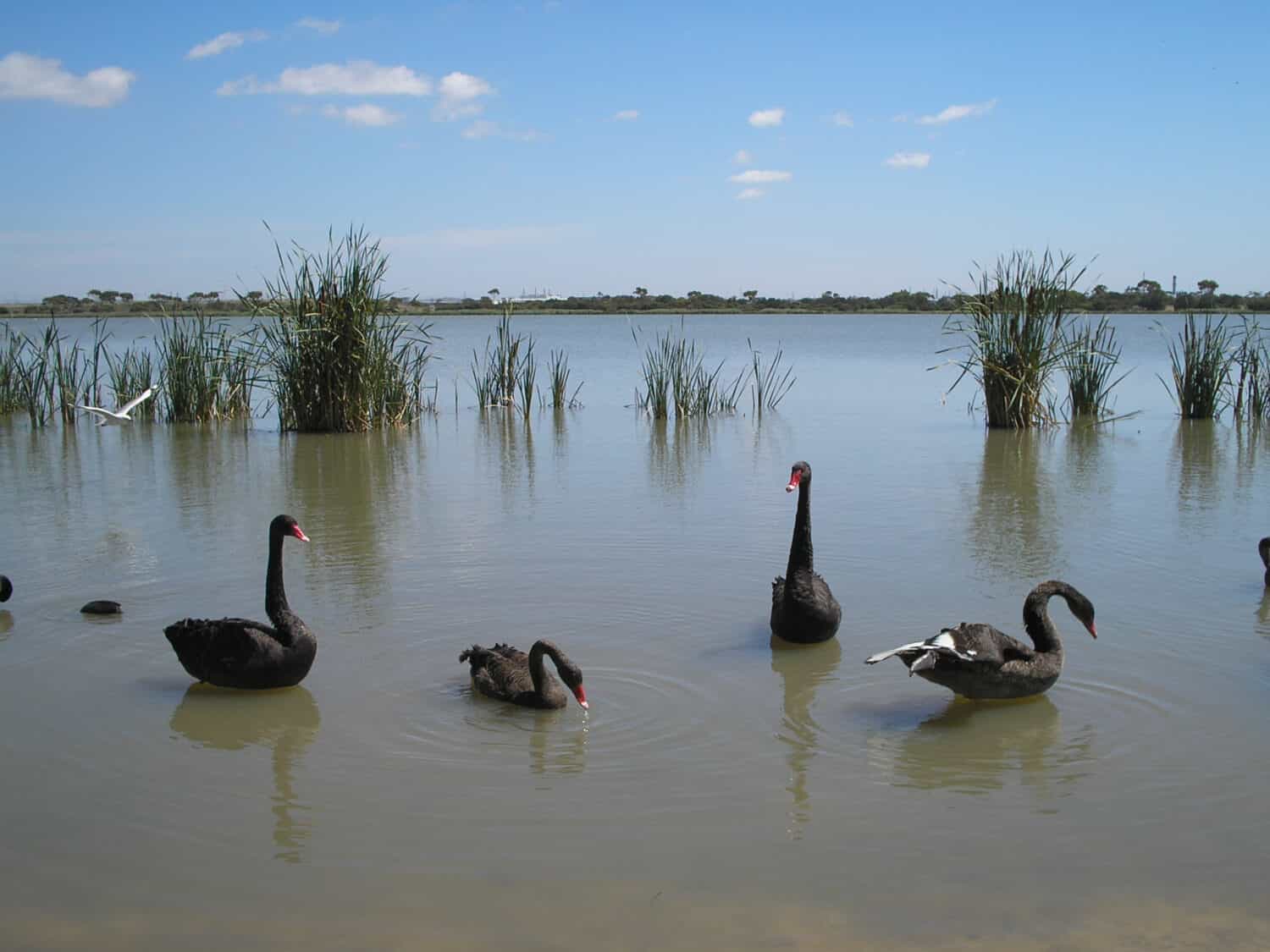
Cherry Lake is one of the most snake-infested lakes in Victoria, notorious for its large population of tiger snakes. Therefore, you should always be vigilant when taking a stroll along its shores.
Image: Norman Nuo Hu, Shutterstock
©Norman Nuo Hu/Shutterstock.com
Cherry Lake is located about 11 miles from Melbourne’s CBD. The lake was once a low-lying wetland spanning 101 hectares. Cherry Lake is one of the most snake-infested lakes in Victoria, notorious for its large population of tiger snakes. Therefore, you should always be vigilant when taking a stroll along its shores. Other snakes that also occur in this area are white-lipped snakes and little whip snakes.
4. Lake Victoria, Shepparton

Lake Victoria, Shepparton was a former swamp and grazing paddock, surrounded by a public park in 1900, named after Queen Victoria. However, in 1929, The former Borough Council developed the lake for recreational purposes, including motor boats, rowing, canoes, and swimming.
©Roni / CC BY-SA 4.0 – License
Lake Victoria, Shepparton was a former swamp and grazing paddock, surrounded by a public park in 1900, named after Queen Victoria. However, in 1929, The former Borough Council developed the lake for recreational purposes, including motor boats, rowing, canoes, and swimming. Furthermore, the park surrounding the lake also provided croquet and bowling facilities, as well as a hockey field.
Unfortunately, they have all been relocated. Lake Victoria is one of the most snake-infested lakes in Victoria, with species like tiger snakes and eastern brown snakes inhabiting the area. Both these species are highly venomous, so visitors to the park and lake need to be extremely careful while walking on trails or swimming in the area.
Summary of the 4 Most Snake-Infested Lakes in Victoria
| Rank | Snake-infested Lakes | Snake Species |
|---|---|---|
| 1 | Gippsland Lakes | Tiger snake, eastern brown snake, lowlands copperhead snake, and red-bellied black snake |
| 2 | Lake Elizabeth | Lowlands copperheads, tiger snakes, and white-lipped snakes |
| 3 | Cherry Lake | White-lipped snakes and little whip snakes. |
| 4 | Lake Victoria | Tiger snakes and eastern brown snakes |
The photo featured at the top of this post is © murbansky/Shutterstock.com
Thank you for reading! Have some feedback for us? Contact the AZ Animals editorial team.







